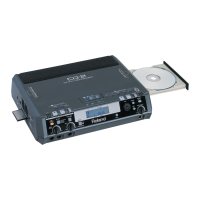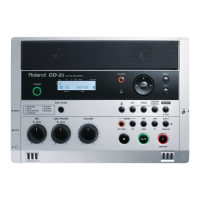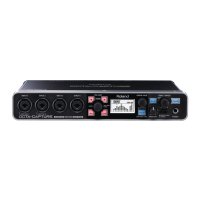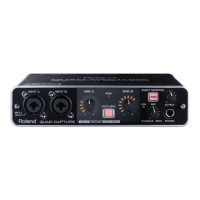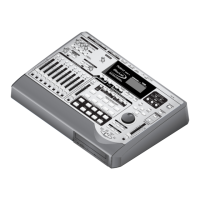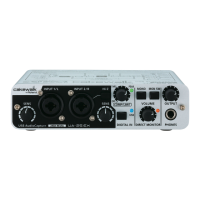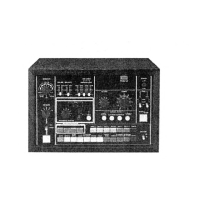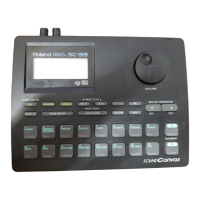Do you have a question about the Roland CM-500 and is the answer not in the manual?
Details the GS/LA sound sources, polyphony, and effects of the CM-500.
Guidelines for safe power connection, usage, and unit placement.
Procedures for cleaning the unit, including recommended and prohibited methods.
Identifies and explains the functions of the front panel controls like Volume, Power Switch.
Identifies and explains the functions of rear panel connectors like MIDI, Phones, Output.
Instructions for connecting the CM-500 to computers and sequencers using MIDI cables.
Guidance on connecting the CM-500's audio outputs to external audio devices.
Details on connecting headphones and their impedance compatibility.
Explains the four operating modes (A, B, C, D) and their intended uses.
Step-by-step instructions on how to change the CM-500's operating mode.
Instructions on safely powering off the unit, including turning down amp volume.
Information about default settings and their effect while the unit is on.
Describes the concept of "parts" in the GS Format, including rhythm parts.
Explains the concept of maximum polyphony and part sounding priority in GS Format.
Details how to select tones using Program Change and Bank Select numbers in GS Format.
Explains how GS Format handles missing tones using alternate voicings.
Describes the general and special use areas within the GS tone map.
Details how chorus and reverb effects can be controlled in GS sound sources.
Explains the dedicated part for drums and how drum sets work.
Explains how drum sets are ranked and changed using program change numbers.
Explains the total number of voices and how they relate to parts in the CM-500.
Discusses preventing voice loss due to polyphony limits using priority and reserve functions.
A checklist for resolving common sound and connectivity problems.
A block diagram illustrating the internal signal flow of the CM-500.
Explains MIDI data exchange, connectors (IN, OUT, THRU), and channels.
Demonstrates controlling Pitch Bend Range using RPN messages with an example.
Describes the data format and address-mapped transfer technique for exclusive messages.
Details the one-way and handshake transfer procedures for MIDI communication.
Chart summarizing transmitted/recognized MIDI functions for GS/LA sound modules.
Details Master Tune settings, All Parameters Reset, and checksum calculation.
Technical specifications for GS and LA sound sources, including parts and polyphony.
Details connectors, power, dimensions, weight, and accessories.
Summarizes MIDI functions including channel, mode, note, velocity, and control messages.
Summarizes MIDI functions specific to the GS sound source.
Details the GS/LA sound sources, polyphony, and effects of the CM-500.
Guidelines for safe power connection, usage, and unit placement.
Procedures for cleaning the unit, including recommended and prohibited methods.
Identifies and explains the functions of the front panel controls like Volume, Power Switch.
Identifies and explains the functions of rear panel connectors like MIDI, Phones, Output.
Instructions for connecting the CM-500 to computers and sequencers using MIDI cables.
Guidance on connecting the CM-500's audio outputs to external audio devices.
Details on connecting headphones and their impedance compatibility.
Explains the four operating modes (A, B, C, D) and their intended uses.
Step-by-step instructions on how to change the CM-500's operating mode.
Instructions on safely powering off the unit, including turning down amp volume.
Information about default settings and their effect while the unit is on.
Describes the concept of "parts" in the GS Format, including rhythm parts.
Explains the concept of maximum polyphony and part sounding priority in GS Format.
Details how to select tones using Program Change and Bank Select numbers in GS Format.
Explains how GS Format handles missing tones using alternate voicings.
Describes the general and special use areas within the GS tone map.
Details how chorus and reverb effects can be controlled in GS sound sources.
Explains the dedicated part for drums and how drum sets work.
Explains how drum sets are ranked and changed using program change numbers.
Explains the total number of voices and how they relate to parts in the CM-500.
Discusses preventing voice loss due to polyphony limits using priority and reserve functions.
A checklist for resolving common sound and connectivity problems.
A block diagram illustrating the internal signal flow of the CM-500.
Explains MIDI data exchange, connectors (IN, OUT, THRU), and channels.
Demonstrates controlling Pitch Bend Range using RPN messages with an example.
Describes the data format and address-mapped transfer technique for exclusive messages.
Details the one-way and handshake transfer procedures for MIDI communication.
Chart summarizing transmitted/recognized MIDI functions for GS/LA sound modules.
Details Master Tune settings, All Parameters Reset, and checksum calculation.
Technical specifications for GS and LA sound sources, including parts and polyphony.
Details connectors, power, dimensions, weight, and accessories.
Summarizes MIDI functions including channel, mode, note, velocity, and control messages.
Summarizes MIDI functions specific to the GS sound source.
| Brand | Roland |
|---|---|
| Model | CM-500 |
| Category | Recording Equipment |
| Language | English |
